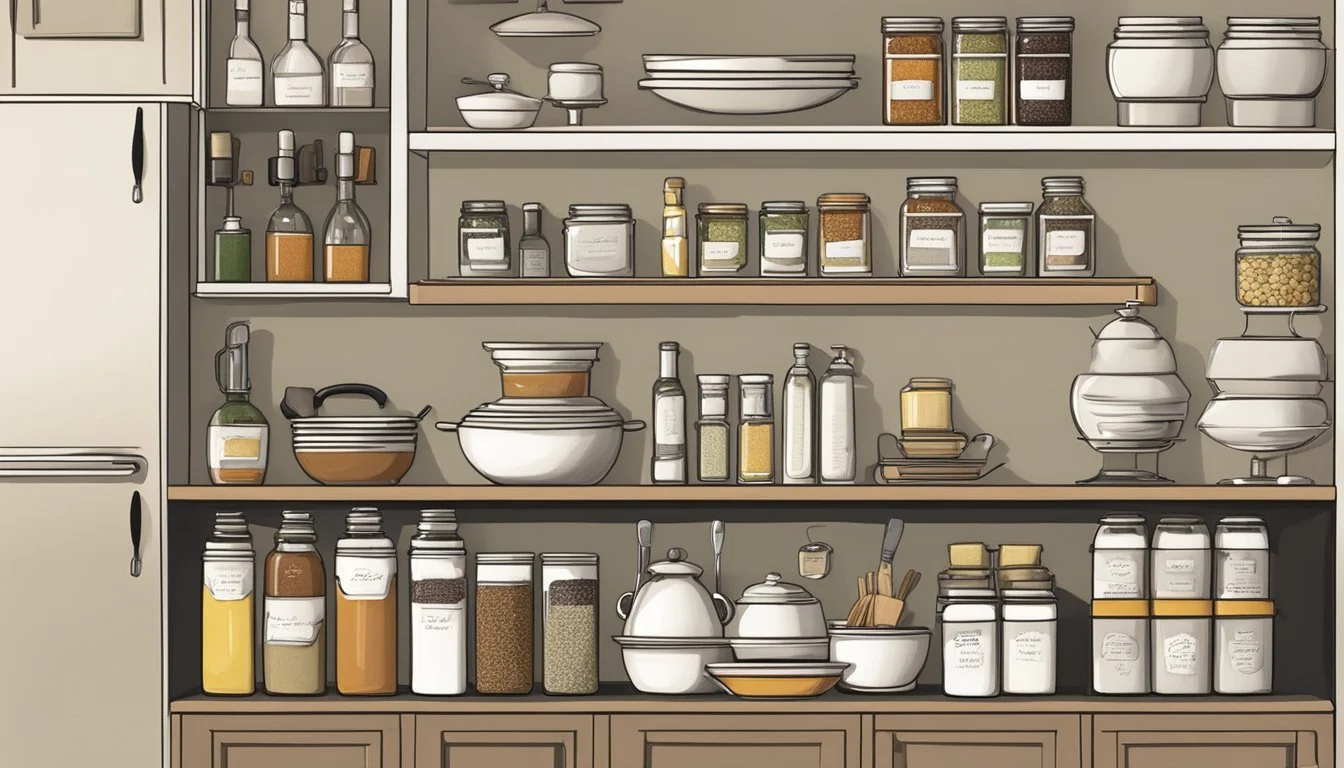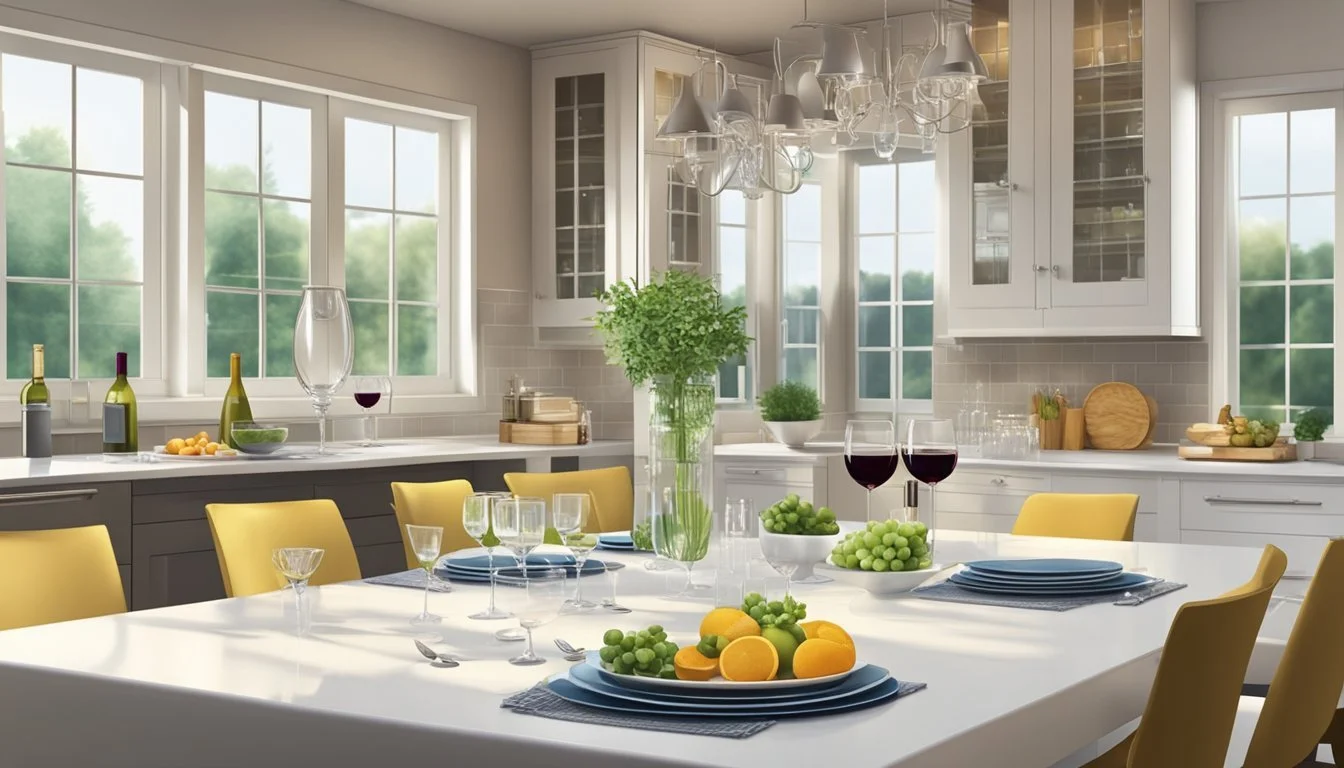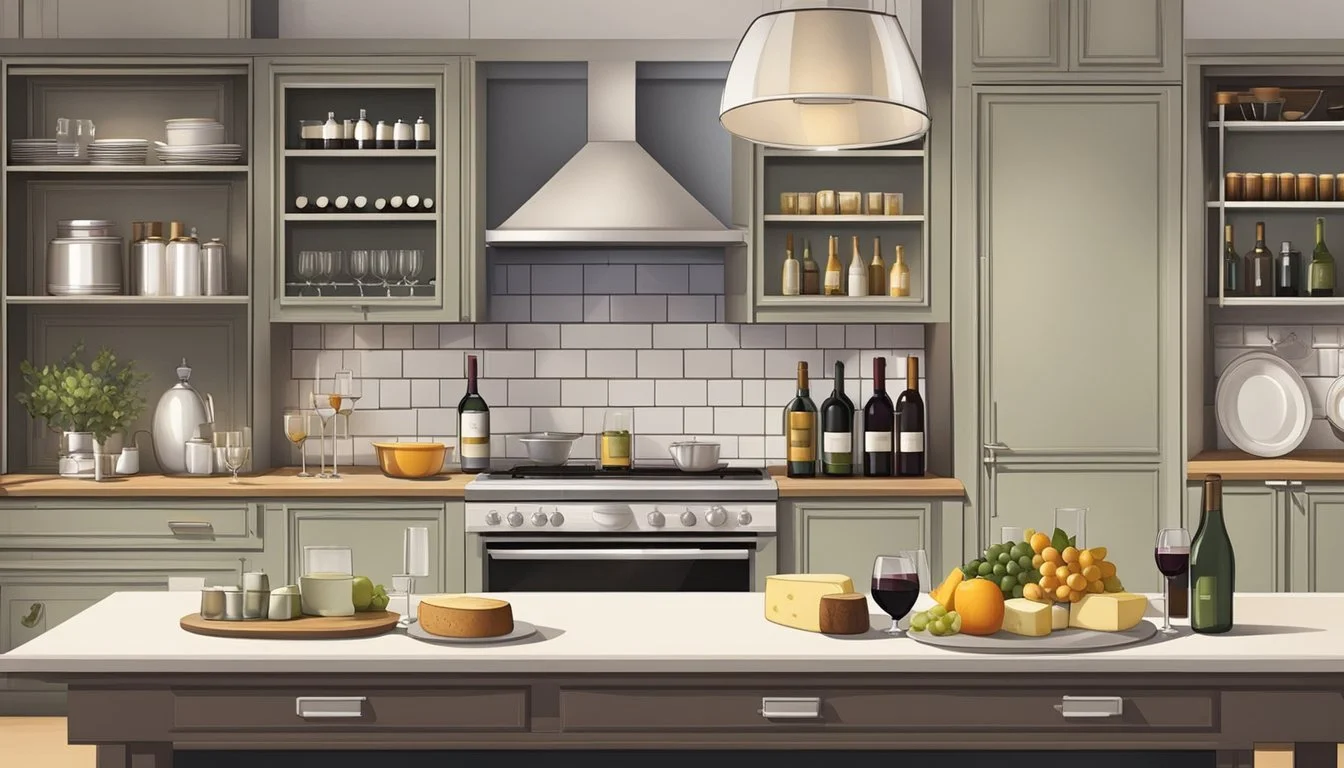5 Tips for Organizing Your Kitchen for a Dinner Party with Wine Pairings
Guide to Effortless Entertaining
Planning a dinner party can present a delightful challenge, especially when it comes to organizing the kitchen for seamless service and creating memorable wine pairings. The key to a successful event is preparation and attention to detail, both of which start in the heart of the home: the kitchen. By optimizing your kitchen space and anticipating your guests' needs, a host can ensure that the evening runs smoothly, allowing them to enjoy the festivities as much as their guests do.
One important aspect of hosting is deciding on a menu that complements the selection of wines being offered. Careful consideration must be given to the flavors and weight of both the dishes and the wines, ensuring they enhance one another. A well-organized kitchen supports this synergy, with areas designated for different courses and the wines paired with them. It also means anticipating how guests will move through the space, whether selecting silverware, serving themselves from a buffet, or re-filling their glasses.
When the food and wine pairings are thoughtfully selected and the kitchen is organized efficiently, the stage is set for a convivial evening. The host can fluidly manage the event from behind the scenes, refilling wine glasses with the proper pours and presenting dishes at their optimum temperature. By mastering these details, the host crafts an atmosphere that encourages guests to relax, engage, and indulge in the culinary and enological journey laid out before them.
Planning Your Dinner Party Menu
When planning a menu for a dinner (What wine goes well with dinner?) party, it is essential to select dishes that complement each other and to understand the basics of food and wine pairing to enhance the dining experience.
Selecting Dishes for the Dinner Party
The host should begin by considering a variety of dishes that fit the occasion, keeping in mind dietary preferences and restrictions of the guests. A balanced menu typically includes:
Appetizer: Start with something light like a Camembert Sauté to whet the appetite.
First Course: A refreshing Chilled Tomato Dill Soup can serve as a palate cleanser.
Main Dish: A centerpiece such as Salmon with Crumb Topping offers substance.
Side Dishes: Complement the main with sides like Lemon Rice and Green Beans with Cashew Gremolata.
Understanding Food and Wine Pairing Basics
The principle "what grows together goes together" is a helpful start when pairing food and wine. Here are some fundamental pairings:
White Wines: Lighter dishes like fish or chicken pair well with white wines such as Chardonnay or Sauvignon Blanc.
Red Wines: Heavier dishes, especially those featuring red meat, are better suited to red wines like Merlot or Cabernet Sauvignon.
Food and wine pairings aim to enhance the overall flavor experience. The balance between the weight of the dish and the body of the wine is key. For instance:
Dish Wine Recommendation Camembert Sauté Light-bodied white wine, like Pinot Grigio Chilled Tomato Dill Soup Dry Rosé Salmon with Crumb Topping Medium-bodied white wine, such as Riesling Lemon Rice Aromatic white wine, like Gewürztraminer Green Beans with Cashew Gremolata Sauvignon Blanc
Proper food and wine pairings can turn a dinner party into a memorable culinary experience.
Choosing the Right Wines
Selecting the perfect wines for a dinner party involves understanding flavor profiles, considering various wine attributes, and thoughtfully pairing wines with each course.
Balancing Flavor Profiles
Wine and food pairings are all about balance. White wines, such as Chardonnay or Sauvignon Blanc, often complement lighter dishes like seafood or salads with their crisp acidity. On the other hand, reds like Cabernet Sauvignon and Syrah stand up to heartier meals, including red meats and rich sauces. For spicy cuisines, an off-dry Riesling can counteract the heat, while a light-bodied Pinot Noir pairs well with earthy flavors. (What wine goes well with earthy flavors?)
Light Dishes: (What wine goes well with light dishes?) Sauvignon Blanc, Chardonnay
Hearty Meals: Cabernet Sauvignon, Syrah
Spicy Flavors: Riesling
Earthy Flavors: Pinot Noir
Wine Selection Considerations
When considering wine options, think about the wine's region, as it greatly influences its characteristics. A California Zinfandel offers robust fruit notes, while an Oregon Pinot Noir may present more earthy and subtle fruit flavors. Additionally, the wine's aging process plays a role; for example, an oaked Chardonnay will have a creamier texture and more complex flavors compared to its unoaked counterpart.
Sweet Wines:
Sparkling: Moscato, Asti Spumante
Dessert: Sauternes, Port
Reds:
Medium-bodied: Merlot, Sangiovese
Full-bodied: Cabernet Sauvignon, Malbec
Whites:
Light-crisp: Pinot Grigio, Sauvignon Blanc
Full-oaked: Chardonnay, Burgundy
Pairing Wines with Courses
Start the meal with lighter wines, moving to full-bodied choices for the main course, and ending with sweet or sparkling wines. Serve Champagne or Prosecco with appetizers (What wine goes well with appetizers?) to refresh the palate. A medium-bodied Grenache or Barbera may accompany the entrée. Finally, a Port or late-harvest Riesling can gracefully conclude the dinner alongside dessert.
Appetizers: Champagne, Prosecco
Entrée: Grenache, Barbera
Dessert: Port, Late-harvest Riesling
In essence, understanding the complexity of wine flavors and how they interplay with food will elevate the dining experience. Consider both the wine's origin and its preparation when selecting the perfect pairing for each course of a dinner party.
Prepping the Kitchen
When hosting a dinner party with wine pairings, a well-prepared kitchen supports a seamless event. The host should focus on creating an inviting atmosphere and ensuring that each dish complements the selected wines.
Organizing Cooking Zones
A kitchen must be organized into efficient zones tailored for prepping, cooking, and serving. One should allocate a specific area for the slow roast, as it requires attention and space. Nearby, set up a centerpiece station, where the aesthetics of plating can enhance the visual appeal of the meal. Ensure that tools and utensils are easily accessible, and group them by their function to save time during food preparation.
Prepping Zone: Dedicated to washing, chopping, and marinating.
Cooking Zone: Contains the stove and oven, positioned for easy transition from prepping.
Plating Zone: Ideally near the serving area, for garnishing and adding final touches.
Streamlining Workflow for Efficiency
To maintain a smooth workflow, one should plan the sequence of cooking to align with serving times. Dishes that can be slow-roasted should be started well in advance, freeing up the oven closer to guests' arrival. By doing so, the host can better manage kitchen activity and focus on complementary pairing with wines. Placement of ingredients and tools should be strategic to minimize unnecessary movement, and a clear counter space is essential for efficient plating.
Ingredient Station: Group ingredients by dish to avoid cross-contamination and to streamline the cooking process.
Tool Accessibility: Store spatulas, tongs, and other utensils near their point of use for quick access.
Wine Station: Set aside an area for wine bottles, glasses, and tools, to ease the process of pouring and serving.
enderit_efficiency_table = """
Task Strategy Slow Roasting Begin early, utilize a timer, keep oven area clear Wine Pairing Arrange wines with corresponding courses Setting Mood Dim lighting, soft music, thoughtful decor Plating & Serving Create a functional and aesthetic plating station """
By thoughtfully organizing the kitchen and streamlining the workflow, one ensures an efficient cooking environment where each dish is prepared in harmony with the wines, and the ambiance sets the perfect mood for the occasion.
Setting the Table and Ambiance
An expertly set table and thoughtfully arranged ambiance are cornerstones of any successful dinner party. When wine is involved, attention to detail can elevate the dining experience, making it memorable for guests.
Creating a Visual Appeal
Visual appeal sets the stage for the evening. A properly set table should feature:
Glasses: Position the water glass at the top right of the dinner plate, slightly above the knife. To the right, place the wineglass for the initial wine pairing.
Utensils: To the right of the plate, lay the knife with the blade facing towards the plate, followed by a spoon if soup will be served. On the left, the dinner fork is placed on a folded napkin, with a salad fork to its left if a salad course is planned.
Dessert Tools: If dessert is part of the menu, a dessert fork and/or spoon can be positioned at the top of the plate or brought out with the course.
Plates: The centerpiece of the setting, the dinner plate, should be flanked by a salad plate and a bread plate with a butter knife if being used.
Table decorations should be low to avoid obstructing views, with colors that complement the tableware and theme of the evening.
Ambiance through Lighting and Music
Lighting and music are pivotal in setting the mood of the dinner party. They should be adjusted to encourage a relaxed yet engaging atmosphere:
Lighting: Dimmed, warm lights or candles can create an intimate and welcoming environment. Ensure the lighting is not too dim to avoid obscuring the beauty of the table setting and the presentation of the food and wine.
Music: A background playlist with a mix of classical, jazz, or soft contemporary music at a moderate volume can enhance the sensory experience without overpowering conversation.
By carefully curating the visual aspects and ambiance of the setting, hosts pave the way for a delightful evening that complements the curated wine pairings.
Executing the Dinner Party
The execution of a dinner party revolves around precise timing and the synchrony between the wine and food served. Guests should experience a seamless transition from one course to the next, with each wine pairing enhancing the flavors of the dishes.
Timing of Each Course
First Course: Appetizers should be ready to serve as soon as the majority of guests arrive. Allow 15-30 minutes for mingling, then transition to the first course.
Main Course: Typically served 30-40 minutes after the appetizers. This allows guests to enjoy the first pairing and prepares their palate for the main meal.
Dessert: Serve approximately 20 minutes after clearing the main course to lend a comfortable pace and give guests time to digest.
Serving Wine and Food in Harmony
Appetizer Pairing:
Bruschetta pairs with a light, crisp Sauvignon Blanc
Bacon-wrapped scallops with a Chardonnay
Main Course Pairing:
Steak with potatoes and vegetables complements a robust Cabernet Sauvignon
Pasta dinner can be paired with a Pinot Noir or a Chianti, depending on the sauce
Dessert Pairing:
Tiramisu pairs delightfully with a sweet Moscato
Chocolate cake is richly matched with a Port or a late-harvest Zinfandel
By adhering to these guidelines, each course will not only be a culinary delight but also a testament to thoughtful planning and impeccable timing.
Pairing Tips and Tricks
When organizing a dinner party, selecting the right wine to complement each dish is crucial. The aim is to balance flavors, allowing both the food and wine to shine without overpowering each other. Here are specific strategies for pairing wines with different seasonings and the dessert course.
Matching Wine with Spices and Seasonings
One must consider the dominant spices and seasonings in a dish to choose the appropriate wine. Here is how to match wine with key flavor profiles:
High Acidity in Wines: Wines with high acidity, such as a Chianti, excel alongside tomato-based dishes that are rich in tartness and seasoned with fresh herbs. The similar acidity levels create a harmonious taste experience.
Wine with Aromatic Spices: For dishes with aromatic spices, opt for wines that present a balance to the complexity of the flavors. For example, a Pinot Noir pairs well with savory roasted duck, whose heavy flavors and natural fats are cut through by the wine's solid acidity.
Wine for the Dessert Course
Desserts call for a thoughtful approach to wine pairing, aiming for a balance between sweetness and flavors.
Sweeter Desserts: A general rule is to select a wine sweeter than the dessert to prevent the wine from tasting bland. For instance, a late-harvest Riesling or a Moscato can complement desserts with a pronounced sweetness.
Dishes with Vinaigrette: When a dessert incorporates elements of tartness or vinaigrette, it's important to choose a wine that can stand up to the dish's acidity without overpowering it. A sparkling wine or Champagne usually does the trick, as the effervescence and acidity can match the tartness of the dessert.







